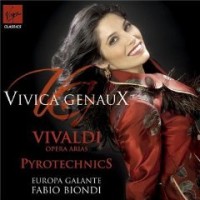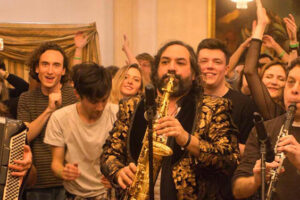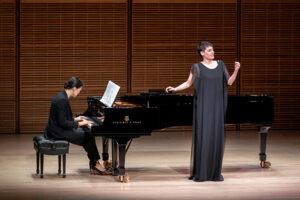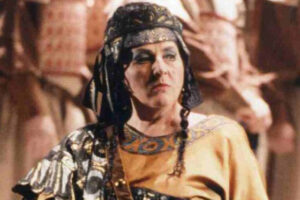
With Händel’s canon largely rediscovered and audiences hungry for more music from the Baroque period, opera houses and recording companies have increasingly turned their attention towards the stage works of Antonio Vivaldi. In only the past decade around 25 of Vivaldi’s operas and pasticcios have been revived, and more and more artists are performing and recording recitals completely or partially devoted to his music.
Both mezzo-soprano Vivica Genaux and violinist/conductor Fabio Biondi have been in the forefront of this Vivaldi renaissance, joining forces for a complete Bajazet as well as Alessandro Scarlatti’s La santissima Trinità.
Pyrotechnics, the team’s new CD (released by EMI/Virgin Classics) focuses on Vivaldi’s most vertiginous coloratura arias, most of them receiving their first performance in modern times.
Although Vivaldi claimed authorship of 94 operas, only about 50 titles have been identified, and around 30 scores have been found, usually in less than complete state, creating incredible headaches for musicologists and conductors. Some of his better known operas (Bajazet, for instance) are pasticcios, where arias from other composers abound. Bajazet’s most famous aria, “Sposa son disprezzata” was originally composed by Giacomelli as “Sposo non mi conosci”. As in most of the other pasticcios, Vivaldi wrote new music for the heroes of this opera, while keeping the other composers’ original music for the villains.
Interestingly enough, he took the trouble to write the recitatives in all of his operas, a task most composers of the time would delegate to their students or even to the singers.
The opening aria on Pyrotechnics, “Come invano il mare irato”, from Catone in Utica, is indicative of the tone of the recording. A quintessential “aria di tempesta”, this Allegro Molto in C major exceeds two octaves in vocal range and features every possible ornamentation the human mind can conceive and the human voice can perform: cascate scempie, cascate doppie, gruppetti, simple trills, ribattuti trills, mordents, trills with mordents, double cadences with mordent, and more. The singer is also required to sing fast coloratura for twelve bars without taking a breath.
Numerous are the “arie di furore”; the most interesting excerpts are “Destin avaro” from La fida ninfa, and “Vibro il ferro” (probably from the opera Ipermestra), where frenzied semiquavers evoke the character’s inner tumult.
Another staple of Baroque opera was the “imitation” aria, which is here represented by “Nella foresta leone invitto” (Catone in Utica), where Emilia compares her suffering to the moans of a wounded lion, with the horns imitating the beast’s roars. Even more emblematic of the genre, “Quell’usignolo” (L’oracolo in Messenia) embodies the time-honored metaphor, the nightingale’s love song.
A few slower-paced arias are welcome in the midst of such relentless, dizzying fireworks. The Larghetto “Vorrei dirti il mio dolore” (from Rosmira fedele) is a touching, subdued love song that makes ample use of the so-called coloratura di grazia, or galante, a light graceful agility to be performed as a gentle arabesque.
My personal favorite aria of the disc is the lament “Splender fra’l cieco orrore,” composed for a revival of Tito Manlio. Vocally more restrained and less demanding, its true allure derives from the orchestral accompaniment, particularly the opposition between the sustained viola and violin parts, and the basso continuo with its brisk semiquavers, which create an uneasy and anxious atmosphere of inexorability, perfectly in tune with the sentiments expressed in the text.
Genaux is squarely in her element and this music fits her instrument like a glove. Although she labels herself a mezzo-soprano, her powerful, sinewy timbre sounds more like a contralto to my ears. Armed with an extremely clean, yet energetic and vigorous agility, the Alaskan singer overcomes the infinite difficulties of Baroque singing with amazing nonchalance and aplomb, demonstrating what “coloratura di forza” really means.
The top is not the very best part of her voice: anything above a high G can often sound a bit squeezed and pinched, especially if sung forte. In this particular recording, however, this limitation is not so pronounced because the tessitura tends to be low, with excursions to the highest register only very rarely sustained.
I am happy to note that on this disc Genaux avoids a mannerism I have noticed in other performances of hers: the straight tone she often employs on a sustained note, particularly at the beginning of an aria or one of its sections. Here she sings almost always with a controlled but full vibrato. Before I get excoriated, I must mention that I am perfectly aware of the controversies surrounding this particular issue. Nonetheless, I am firmly entrenched in the camp of those scholars (these days the majority) who believe that Baroque singing required a vibrato rich in overtones, where the straight tone (nota fissa) was employed as an occasional effect, and not as the norm.
Sicilian conductor Biondi and his orchestra Europa Galante are nothing short of magnificent. The rhythmic vigor with which Mr. Biondi leads the original instruments of his ensemble is infused with a sort of enthralling, gripping nervousness and tension. This irresistible race towards an objective embodies the highly imaginative expression of the Baroque aesthetic, with its taste for “wonder” (“il meraviglioso”) and its desire for the impossible. Such a vibrant and intoxicating musical route makes his interpretation extremely original and distinctive. His dynamics are clean and sharp, electrified by feverish excitement. It is a vision of Baroque music light-years away from so many anemic Baroque specialists.
In a few succinct words, this CD is a valuable, exhilarating addition to the growing number of Italian vocal Baroque recordings. Listening to it is pure pleasure, not a “sacrificium!”
























Comments